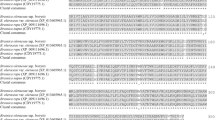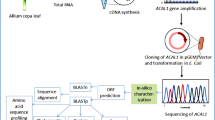Abstract
Two lectins were isolated from Robinia pseudoacacia (black locust) seeds using affinity chromatography on fetuin-agarose, and ion exchange chromatography on a Neobar CS column. The first lectin, R. pseudoacacia seed agglutinin I, referred to as RPsAI, is a homotetramer of four 34 kDa subunits whereas the second lectin, referred to as RPsAII, is composed of four 29 kDa polypeptides. cDNA clones encoding the polypeptides of RPsAI and RPsAII were isolated and their sequences were determined. Both polypeptides are translated from mRNAs of ca. 1.2 kb encoding a precursor carrying a signal peptide. Alignment of the deduced amino acid sequences of the different clones indicates that the 34 and 29 kDa seed lectin polypeptides show 95% sequence identity. In spite of this striking homology, the 29 kDa polypeptide has only one putative glycosylation site whereas the 34 kDa subunit has four of these sites. Carbohydrate analysis revealed that the 34 kDa possesses three carbohydrate chains whereas the 29 kDa polypeptide is only partially glycosylated at one site. A comparison of the deduced amino acid sequences of the two seed and three bark lectin polypeptides demonstrated unambiguously that they are encoded by different genes. This implies that five different genes are involved in the control of the expression of the lectins in black locust.
Similar content being viewed by others
Abbreviations
- LECRPAs:
-
cDNA clone encoding Robinia pseudoacacia seed lectin
- LoLI:
-
Lathyrus ochrus isolectin I
- PsA:
-
Pisum sativum agglutinin
- RPbAI:
-
Robinia pseudoacacia bark agglutinin I
- RPbAII:
-
Robinia pseudoacacia bark agglutinin II
- RPsAI:
-
Robinia pseudoacacia seed agglutinin I
- RPsAII:
-
Robinia pseudoacacia seed agglutinin II
References
Becker JW, Reeke Jr GN, Wang JL, Cunnigham BA, Edelman GM: The covalent and three-dimensional model of concanavalin A. III. Structure of the monomer and its interaction with metals and saccharides. J Biol Chem 250: 1513–1524 (1975).
Bourne Y, Abergel C, Cambillau C, Frey M, Rougé P, Fontecilla-Camps JC: X-ray crystal structure determination and refinement at 1.9 Å resolution of isolectin I from the seeds of Lathyrus ochrus. J Mol Biol 214: 571–584 (1990).
Bourne Y, Roussel A, Frey M, Rougé P, Fontecilla-Camps JC, Cambillau C: Three-dimensional structures of complexes of Lathyrus ochrus isolectin I with glucose and mannose: fine specificity of the monosaccharide binding site. Proteins 8: 365–376 (1990).
Dubois M, Gilles KA, Hamilton JK, Rebers PA, Smith F: Colorimetric method for determination of sugar and related substances. Anal Chem 28: 350–356 (1956).
Einspahr H, Parks EH, Suguna K, Subramanian E, Suddath FL: The crystal structure of pea lectin at 3.0-Å resolution. J Biol Chem 261: 16518–16527 (1986).
Fleischmann G, Rüdiger H: Isolation, resolution and partial characterization of two Robinia pseudoacacia seed lectins. Biol Chem Hoppe-Seyler 367: 27–32 (1986).
Gaboriaud C, Bissery V, Benchetrit T, Mornon JP: Hydrophobic cluster analysis: an efficient new way to compare and analyse amino acid sequences. FEBS Lett 224: 149–155 (1987).
Goldstein IJ, Poretz RD: Isolation, physicochemical characterization and carbohydrate-binding specificity of lectins. In: Liener IE, Sharon N, Goldstein IJ (eds) The Lectins: Properties, Functions and Applications in Biology and Medicine, pp. 33–248. Academic Press, New York (1986).
Hankins CN, Kindinger JI, Shannon LM: The lectins of Sophora japonica. II. Purification, properties, and N-terminal amino acid sequences of five lectins from bark. Plant Physiol 86: 67–70 (1988).
Hoffman LM, Donaldson DD: Characterization of two Phaseolus vulgaris phytohemagglutinin genes closely linked on the chromosome. EMBO J 4: 883–889 (1985).
Hopp TP, Woods KR: Prediction of protein antigenic determinants from amino acid sequences. Proc Natl Acad Sci USA 78: 3824–3828 (1981).
Horejsi V, Haskovec C, Kocourek J: Studies on lectins. XXXVIII. Isolation and characterization of the lectin from black locust bark (Robinia pseudoacacia L.). Biochim Biophys Acta 532: 98–104 (1978).
Janin J: Surface and inside volumes in globular proteins. Nature 277: 491–492 (1979).
Karplus PA, Schulz GE: Prediction of chain flexibility in proteins. Naturwissenschaften 72: 212–213 (1985).
Kyte J, Doolittle RF: A simple method for displaying the hydropathic character of a protein. J Mol Biol 157: 105–132 (1982).
Laemmli UK: Cleavage of structural proteins during the assembly of the head of bacteriophage T4. Nature 227: 680–685 (1970).
Lemesle-Varloot L, Henrissat B, Gaboriaud C, Bissery V, Morgat A, Mornon JP: Hydrophobic cluster analysis: procedure to derive structural and functional information from 2-D-representation of protein sequences. Biochimie 72: 555–574 (1990).
Maniatis T, Fritsch EF, Sambrook J: Molecular Cloning: A Laboratory Manual. Cold Spring Harbor Laboratory, Cold Spring Harbor, NY (1982).
Mierendorf RC, Pfeffer D: Direct sequencing of denatured plasmid DNA. Meth Enzymol 152: 556–562 (1987).
Nsimba-Lubaki M, Peumans WJ: Seasonal fluctuations of lectins in barks of elderberry (Sambucus nigra) and black locust (Robinia pseudoacacia). Plant Physiol 80: 747–751 (1986).
Parker JMR, Guo D, Hodges RS: New hydrophilicity scale derived from high-performance liquid chromatography peptide retention data: correlation of predicted surface residues with antigenicity and X-ray-derived accessible sites. Biochemistry 25: 5425–5432 (1986).
Peumans WJ, Nsimba-Lubaki M, Broekaert WF, Van Damme EJM: Are bark lectins of elderberry (Sambucus nigra) and black locust (Robinia pseudoacacia) storage proteins? In: Shannon LM, Chrispeels MJ (eds) Molecular Biology of Seed Storage Proteins and Lectins, pp. 53–63. the American Society of Plant Physiologists, Waverly Press, Baltimore, MD (1986).
Poretz RP, Riss H, Timberlake JW, Chien S: Purification and properties of the hemagglutinin from Sophora japonica seeds. Biochemistry 13: 250–256 (1974).
Rougé P, Cambillau C, Bourne Y: The three-dimensional structure of legume lectins. In: Kilpatrick DC, Van Driessche E, Bog-Hansen TC (eds) Lectin Reviews, Vol. 1, pp. 143–159. Sigma Chemical Co., St Louis, MO (1991).
Sanger F, Nicklen S, Coulson AR: DNA sequencing with chain terminating inhibitors. Proc Natl Acad Sci USA 74: 5463–5467 (1977).
Sharon N, Lis H: Legume lectins — a large family of homologous proteins. FASEB J 4: 3198–3208 (1990).
Tazaki K, Yoshida K: The bark lectin of Robinia pseudoacacia: purification and partial characterization. Plant Cell Physiol 33: 125–129 (1992).
Thornton JM, Edwards MS, Taylor WR, Barlow DJ: Location of continuous antigenic determinants in the protruding regions of proteins. EMBO J 5: 409–413 (1986).
Van Damme EJM, Goldstein IJ, Vercammen G, Vuylsteke J, Peumans WJ: Lectins of members of the Amaryllidaceae are encoded by multigene families which show extensive homology. Physiol Plant 86: 245–252 (1992).
Van Damme EJM, Smeets K, Torrekens S, Van Leuven F, Goldstein IJ, Peumans WJ: The closely related homomeric and heterodimeric mannose-binding lectins from garlic are encoded by one-domain and two-domain lectin genes, respectively. Eur J Biochem 206: 413–420 (1992).
Van Damme EJM, Peumans WJ: Cell-free synthesis of lectins. In: Gabius H-J, Gabius S (eds) Lectins and Glycobiology, pp. 458–468. Springer Verlag, Berlin/Heidelberg/New York (1993).
Van Damme EJM, Barre A, Smeets K, Torrekens S, Van Leuven F, Rougé P, Peumans WJ: The bark of Robinia pseudoacacia contains a complex mixture of lectins. Plant Physiol 107: 833–843 (1995).
Wantyghem J, Goulut C, Frénoy J-P, Turpin E, Goussault Y: Purification and characterization of Robinia pseudoacacia seed lectins. Biochem J 237: 483–489 (1986).
Wantyghem J, Platzer N, Giner M, Derappe C, Goussault Y: Structural analysis of the carbohydrate chain of glycopeptides isolated from Robinia pseudoacacia seed lectins. Carbohydrate Res 236: 181–193 (1992).
Yamamoto K, Ishida C, Saito M, Konami Y, Osawa T, Irimura T: Cloning and sequence analysis of the Maackia amurensis hemagglutinin cDNA. Glycoconjugate J 11: 572–575 (1994).
Author information
Authors and Affiliations
Rights and permissions
About this article
Cite this article
Van Damme, E.J.M., Barre, A., Rougé, P. et al. The seed lectins of black locust (robinia pseudoacacia) are encoded by two genes which differ from the bark lectin genes. Plant Mol Biol 29, 1197–1210 (1995). https://doi.org/10.1007/BF00020462
Received:
Accepted:
Issue Date:
DOI: https://doi.org/10.1007/BF00020462




